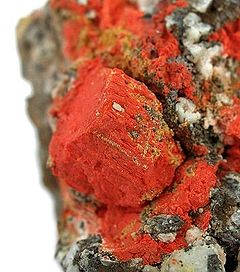Minium (mineral)
| Minium | |
|---|---|

|
|
| General | |
| Category | Oxide mineral |
|
Formula (repeating unit) |
Pb2+2Pb4+O4 |
| Strunz classification | 4.BD.05 |
| Dana classification | 07.02.08.01 |
| Crystal system | Tetragonal |
| Crystal class | Ditetragonal dipyramidal (4/mmm) H-M symbol: (4/m 2/m 2/m) |
| Space group | P42/mbc |
| Unit cell | a = 8.811(5) Å, c = 6.563(3) Å; Z = 4 |
| Identification | |
| Color | Scarlet to brownish red, may have a yellowish tint |
| Crystal habit | Scaly; commonly as earthy, pulverulent masses |
| Cleavage | Perfect on {110} and {010} |
| Mohs scale hardness | 2.5 |
| Luster | Dull to slightly greasy |
| Streak | Yellow-orange |
| Diaphaneity | Semitransparent |
| Specific gravity | 8.9 - 9.2 |
| Optical properties | Uniaxial |
| Refractive index | n = 2.42 |
| References | |
Minium is the naturally occurring form of lead tetroxide, Pb2+2Pb4+O4 also known as red lead. Minium is a light-to-vivid red and may have brown-to-yellow tints. It typically occurs in scaly-to-earthy masses. It crystallizes in the tetragonal crystal system.
Minium is rare and occurs in lead-mineral deposits that have been subjected to severe oxidizing conditions. It also occurs as a result of mine fires. It is associated with cerussite, galena, litharge, massicot, mimetite, native lead, and wulfenite.
It occurs in relatively small amounts throughout the world: Langhecke, Hesse; Badenweiler, Baden-Württemberg; Bleialf, Eifel district; Horhausen (Grube Holzappel), Rhineland-Palatinate in Germany. It occurs at Mies, Slovenia; Leadhills, Lanarkshire, Scotland; Castelberg St. Avold, Moselle, France; from Langban, Varmland, Sweden; Sarrabus, Sardinia, Italy; near Anarak, Iran; and Tsumeb, Namibia. In the US, mines include the Jay Gould mine, Alturas County, Idaho; the Leadville district, Lake County, Colorado; and in the Tonopah-Belmont mine, Maricopa County, Arizona. It also occurs in Eschuchapa and Guerrero, Mexico. Good specimens were produced by a mine fire at the Broken Hill mine in New South Wales, Australia.
...
Wikipedia
